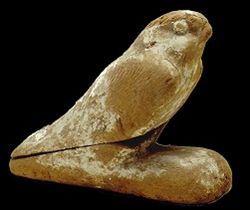
Ein ägyptischer Totengott in Gestalt eines Falken. Er wurde vor allem in der Nekropole von Memphis, Saqqara, verehrt. Dieser Ort ist vielleicht sogar nach dem Gott benannt. Außer dem Tempel in Saqqara besaß der Gott auch andere Kultzentren, von denen einige noch nicht lokalisiert werden konnten. In Giza war er der Herr des Zugangs zur Unterwelt (Rosetau). Sein Heiligtum in der Nekropole von Memphis wurde die Schetit genannt. Totentexte aus dem Neuen Reich, wie etwa das Amduat, die in verschiedenen königlichen Gräbern im Königsgräbertal angebracht sind, erwähnen das Reich des Sokar 'der auf seinem Sand ist', einem tief in der Unterwelt, in der vierten und fünften Stunde des Amduat, gelegenen Ort. Bereits im Alten Reich wurde Sokar mit Ptah, dem Gott von Memphis, verbunden; daraus entstand der Gott Ptah-Sokar, der gewöhnlich als Mann mit Falkenkopf oder ganz in Falkengestalt dargestellt wird. Wegen seiner Funktion als Totengott hatte Sokar auch ein Verhältnis zu dem wohlbekannten Totengott Osiris, und in vielen Texten wird Ptah-Sokar-Osiris erwähnt. Eines der wichtigsten Totenfeste in Ägypten war das Sokarfest. Es wird bereits in den ersten Dynastien erwähnt. Aus späterer Zeit wissen wir, daß das Sokarfest im Monat Choiak stattfand. Es war ein Fest, daß in der Mitte eines wichtigen 10-tägigen Festes stattfand, daß am 30. Choiak mit dem Aufrichten des Djed-Pfeilers zu Ende ging und daher ein Fest des Osiris war. Der Tag des Sokarfestes, der 26. Choiak, wurde in ptolemäischer Zeit mit der Wintersonnenwende in Zusammenhang gebracht, die im Alexandrinischen Kalender ebenfalls auf den 26. Choiak fiel. Drei tage zuvor wurde das Fest des Erdaufhackens, ein landwirtschaftliches Fest, gefeiert. Das Choiakfest fiel im gewöhnlichen Kalender tatsächlich mit dem Beginn der Feldarbeit zusammen.